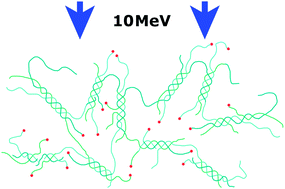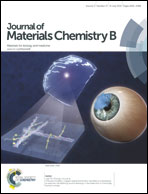Tailoring the material properties of gelatin hydrogels by high energy electron irradiation†
Abstract
Natural hydrogels such as gelatin are highly desirable biomaterials for application in drug delivery, biosensors, bioactuators and extracellular matrix components due to strong biocompatibility and biodegradability. Typically, chemical crosslinkers are used to optimize material properties, often introducing toxic byproducts into the material. In this present work, electron irradiation is employed as a reagent-free crosslinking technique to precisely tailor the viscoelasticity, swelling behavior, thermal stability and structure of gelatin. With increasing electron dose, changes in swelling behavior and rheology indicate increasing amounts of random coils and dangling ends as opposed to helical content, a result confirmed through Fourier transform infrared spectroscopy. Gel fraction, rheology and swelling measurements at 37 °C were used to verify thermal stability in biological conditions. Scanning electron microscopy images of dried gelatin samples support these conclusions by revealing a loss of free volume and apparent order in the fracture patterns. The degree of crosslinking and mesh size are quantified by rubber elasticity theory and the Flory–Rehner equation. Overall, precise control of material properties is demonstrated through the interplay of concentration and irradiation dose, while providing an extensive parameter–property database suitable for optimized synthesis.


 Please wait while we load your content...
Please wait while we load your content...